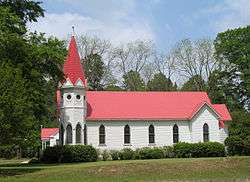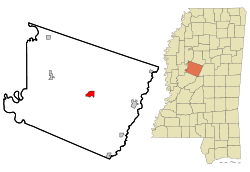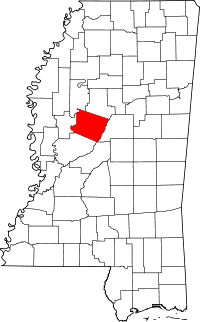Lexington, Mississippi
Lexington is a city in and the county seat of Holmes County, Mississippi, United States. The county was organized in 1833 and the city in 1836. The population was 1,731 at the 2010 census,[3] down from 2,025 at the 2000 census. The estimated population in 2018 was 1,496.[4] It has declined from its high of 3198 in 1950 due to the expansion of industrial-scale agriculture. Because of the difficulties in making a living, many people have left the rural county to seek work elsewhere.
Lexington, Mississippi | |
|---|---|
 St. Mary's Episcopal Church | |
 Location of Lexington, Mississippi | |
 Lexington, Mississippi Location in the United States | |
| Coordinates: 33°6′52″N 90°3′4″W | |
| Country | United States |
| State | Mississippi |
| County | Holmes |
| Government | |
| • Mayor | Robin McCrory |
| Area | |
| • Total | 2.42 sq mi (6.27 km2) |
| • Land | 2.42 sq mi (6.26 km2) |
| • Water | 0.00 sq mi (0.01 km2) |
| Elevation | 233 ft (71 m) |
| Population (2010) | |
| • Total | 1,731 |
| • Estimate (2019)[2] | 1,453 |
| • Density | 601.16/sq mi (232.06/km2) |
| Time zone | UTC-6 (Central (CST)) |
| • Summer (DST) | UTC-5 (CDT) |
| ZIP code | 39095 |
| Area code(s) | 662 |
| FIPS code | 28-40600 |
| GNIS feature ID | 0672434 |
History
Incorporated in 1836, the city of Lexington was founded by European-American settlers after most of the Choctaw people, who had long occupied this area, were forced to cede their land to the United States and remove to the Indian Territory. The new settlers initially developed riverfront land along the Yazoo and Black rivers for cotton plantations, primarily worked by enslaved African Americans. The slaves were brought by planters with them from the Upper South or transported in the domestic slave trade. In total, more than one million African Americans were transported to the Deep South, breaking up many families. The African-descended slaves soon constituted the majority of the Holmes County population.
On court days, the town served as a trading center for the county and attracted retail merchants. Lexington was a destination in the 1830s of some German-Jewish immigrants, who often became merchants. They were joined much later in the century by Russian Jewish immigrants. The Jewish community built Temple Beth El in Lexington in 1905; it closed in 2009 because of declining population.[5] During the plantation era, the city was bustling, as planters grew wealthy from the booming demand for cotton in the North and Europe.
Among the early settlers in the 1830s was German-Jewish immigrant Jacob Sontheimer, who first worked caring for an elderly planter. After being bequeathed land, Sontheimer later became a merchant in town. His two daughters, Rose and Bettie, also became merchants, managing the Sontheimer business. He was joined by other Jewish immigrants from Germany, totaling about 20 by the late 1870s and 50 by 1900. In the later years Jewish immigrants also came from eastern Europe to Lexington. They developed tailoring and grocery businesses; the Lewis Grocery Store developed into a major wholesaler in the state.[5][6]
After the Civil War, freedmen in Holmes County, who constituted the majority of the population, joined the Republican Party and elected several county sheriffs and other local officers. They sought education and some became landowners, clearing land in the bottomlands and selling their timber to raise money for purchase. This progress was before 1890, when they were essentially deprived of the vote by the state legislature passing a new constitution, which created barriers to voter registration and forced them out of politics for decades into the late 20th century. In the late 19th and early 20th centuries, financial recession and lack of political clout meant that many freedmen lost their land; within a generation they had regressed to the status of sharecropper and tenant farmer.
20th century to present
.jpg)
Edmund F. Noel, an attorney in Lexington, was a son of planters Leland and Margaret Noel, from Virginia and North Carolina, respectively. His father had developed cotton plantations in Holmes County in the antebellum period. The younger Noel became a politician, elected as a state legislator and later as District Attorney. In 1906 he was elected as governor of Mississippi, serving through 1912. His house at North Street is listed on the National Register of Historic Places for its distinctive architecture, and is known as the "Gov. Edmond F. Noel House". It was bequeathed to him by his mother.
In the early 20th century, Mississippi planters recruited Chinese immigrant workers to satisfy the demand for farm labor, and some came to Holmes County. As the area suffered from the boll weevil infestation, the cotton crops suffered. Agricultural mechanization reduced the need for farm labor, leading to a decline in county and town populations from the 1930s on. Many African Americans left the South for northern and midwestern industrial cities, seeking more opportunities and escape from the violence of lynchings and oppression of Jim Crow rules.
In the 1940s, two lynchings of black men took place in or near Lexington: singer B.B. King later recounted having seen a youth hanged in the courthouse square during the short time he was living there as a teenager, about 1942–1944. The body of 35-year-old Leon McTatie was found on 24 July 1946 in a bayou in nearby Sunflower County. He was beaten to death for allegedly stealing a saddle. Six white men were charged in his lynching but quickly acquitted at trial.[7][8]
Lexington was distinguished by two nationally known women: Arenia Mallory, an African-American music teacher from Illinois, started teaching at the newly established Saints Academy in Lexington in 1926, which was affiliated with the Church of God in Christ. She led the school for more than 50 years, expanding its programs to grades 1-12, and establishing a junior college. She developed the school from the early 20th century as a model of academic excellence for African-American students. During her long tenure, she also founded an associated junior college. During the 1960s, she was appointed by President John F. Kennedy to national positions and committees in the federal government.
Hazel Brannon Smith, a white woman from an upper-class family, was based in Lexington, where she owned and published several rural newspapers. She promoted integration and change in the region during the civil rights era, winning a Pulitzer Prize for her editorials in 1964, the year of Freedom Summer and the Mississippi Freedom Democratic Party, organized by African Americans before the Voting Rights Act of 1965 was passed by Congress.
Geography
Lexington is in the center of Holmes County on the north side of the valley of Black Creek, a west-flowing tributary of the Yazoo River. Mississippi Highways 12 and 17 pass through the city, sharing four blocks of Carrollton Street north of the city center. Highway 12 leads east 13 miles (21 km) to Durant and northwest 11 miles (18 km) to Tchula, while Highway 17 leads north 30 miles (48 km) to Carrollton and south 18 miles (29 km) to Pickens.
According to the United States Census Bureau, the city has a total area of 2.4 square miles (6.3 km2), of which 9,785 square metres (2.4 acres), or 0.16%, are water.[3]
Climate
The climate in this area is characterized by hot, humid summers and generally mild to cool winters. According to the Köppen Climate Classification system, Lexington has a humid subtropical climate, in common with the vast majority of the American South.[9]
Demographics
The table to the right shows two periods of dramatic population declines: from 1910 to 1920, and in the decades after 1960. These are periods of mechanization of agriculture and consolidation of land into large, industrial holdings. Many African Americans left the area in the Great Migration, particularly before passage of civil rights legislation, for better jobs elsewhere and to escape Jim Crow.
| Historical population | |||
|---|---|---|---|
| Census | Pop. | %± | |
| 1850 | 656 | — | |
| 1860 | 887 | 35.2% | |
| 1870 | 744 | −16.1% | |
| 1880 | 798 | 7.3% | |
| 1890 | 1,075 | 34.7% | |
| 1900 | 1,516 | 41.0% | |
| 1910 | 2,428 | 60.2% | |
| 1920 | 1,792 | −26.2% | |
| 1930 | 2,590 | 44.5% | |
| 1940 | 2,930 | 13.1% | |
| 1950 | 3,198 | 9.1% | |
| 1960 | 2,839 | −11.2% | |
| 1970 | 2,756 | −2.9% | |
| 1980 | 2,628 | −4.6% | |
| 1990 | 2,227 | −15.3% | |
| 2000 | 2,025 | −9.1% | |
| 2010 | 1,731 | −14.5% | |
| Est. 2019 | 1,453 | [2] | −16.1% |
| U.S. Decennial Census[10] | |||
As of the census[11] of 2000, there were 2,025 people, 725 households, and 503 families residing in the city. The population density was 825.6 people per square mile (319.1/km2). There were 802 housing units at an average density of 327.0 per square mile (126.4/km2). The racial makeup of the city was 31.36% White, 67.26% African American, 0.05% Native American, 0.64% Asian, and 0.69% from two or more races. Hispanic or Latino of any race were 1.98% of the population.
There were 725 households, out of which 30.3% had children under the age of 18 living with them, 37.8% were married couples living together, 26.3% had a female householder with no husband present, and 30.5% were non-families. 28.8% of all households were made up of individuals, and 15.4% had someone living alone who was 65 years of age or older. The average household size was 2.70 and the average family size was 3.34.
In the city, the population was spread out, with 28.5% under the age of 18, 11.1% from 18 to 24, 26.9% from 25 to 44, 17.9% from 45 to 64, and 15.7% who were 65 years of age or older. The median age was 35 years. For every 100 females, there were 91.0 males. For every 100 females age 18 and over, there were 83.1 males.
The median income for a household in the city was $22,163, and the median income for a family was $29,732. Males had a median income of $25,750 versus $17,328 for females. The per capita income for the city was $14,614. About 32.7% of families and 37.2% of the population were below the poverty line, including 54.5% of those under age 18 and 28.4% of those age 65 or over.
As of the 2010 Census, the racial composition of the city was:
- 71.8% Black or African American;
- 27.0% White
- 0.06% from other races;
- 0.5% Asian;
- 0.5% from two or more races;
- 0.1% American Indian;
- 0.0% Pacific Islander.
Education
The city of Lexington is served by the Holmes County School District. William Dean Jr. Elementary School, and Holmes County Central High School (in the former J. J. McClain High School) are located in the area. The community previously also housed Lexington Elementary School.[12]
Lexington was previously home to Saints Industrial and Literary School, later known as Saints Academy. Founded in 1918, this private school for African-American students was established by the Church of God in Christ. Arenia Mallory, from Illinois, began as a music teacher and became principal and president of the school. She led its growth and the setting of high academic standards to provide opportunity to black students; the school had a national reputation. The school was expanded as Saints Academy and Junior College, and Saints College.
Another private school in the city, Central Holmes Christian School (formerly Central Holmes Academy, was established in 1967 as a segregation academy).[13]
Notable people
- Chalmers Archer, author, academic and U.S. Special Forces veteran
- Malachi Favors, jazz bassist
- B.B. King, musician, lived in Lexington
- Alexander Lane (1857–1911), Illinois state representative and physician, born in Lexington[14]
- Arenia Mallory, African-American educator and activist, principal of the Saints Academy and founder of its junior college
- Charles Harrison Mason, founder of the Church of God in Christ, an evangelical church which grew to have a national presence
- Edmond Favor Noel, attorney, Governor of Mississippi 1908–1912; son of Leland Noel, an early planter in Holmes County who migrated from Virginia and became one of the largest slaveholders before the Civil War
- Milton L. Olive III, (1946-1965) United States Army Soldier and recipient of the Medal of Honor
- Lonnie Pitchford, blues musician born in Lexington
- Monroe Saffold Jr., American bodybuilder, first place Masters Mr. America AAU, tall division 1990
- Hazel Brannon Smith (1914–1994), owner and publisher of the Lexington Advertiser and other local newspapers; first woman to win the Pulitzer Prize for Editorial Writing
- Neely Tucker, journalist, author
- Hattie Winston, actress in television, film and theatre
See also
References
- "2019 U.S. Gazetteer Files". United States Census Bureau. Retrieved July 26, 2020.
- "Population and Housing Unit Estimates". United States Census Bureau. May 24, 2020. Retrieved May 27, 2020.
- "Geographic Identifiers: 2010 Census Summary File 1 (G001): Lexington city, Mississippi". American Factfinder. U.S. Census Bureau. Archived from the original on February 13, 2020. Retrieved August 17, 2017.
- "Population and Housing Unit Estimates". Retrieved January 5, 2020.
- "A Final Yom Kippur in the Delta for Mississippi Community Begun in 1830s", The Jewish Daily Forward
- "ISJL - Mississippi Lexington Encyclopedia". Goldring/Woldenberg Institute of Southern Jewish Life. Retrieved 30 November 2018.
- Susan Glenn, " 'We Charge Genocide': The 1951 Black Lives Matter Campaign", Mapping American Social Movements through the 20th Century, University of Washington website; retrieved 9 March 2018
- Jason Sokol, There Goes My Everything: White Southerners in the Age of Civil Rights, 1945-1975, Knopf Doubleday Publishing Group, 2008, p. 28
- "Lexington, Mississippi Köppen Climate Classification (Weatherbase)". Weatherbase. Retrieved 30 November 2018.
- "Census of Population and Housing". Census.gov. Retrieved June 4, 2015.
- "U.S. Census website". United States Census Bureau. Retrieved 2008-01-31.
- "Schools." Holmes County School District. July 28, 2014. Retrieved on July 9, 2017. "Lexington Elementary School 209 Pine Street Lexington, MS 39095"
- "Contact Us Archived 2013-10-03 at the Wayback Machine." Central Holmes Christian School. Retrieved on March 23, 2013. "130 Robert E. Lee Street Lexington, MS 39095"
- 'Illinois Blue Book 1909-1910,' Biographical Sketch of Alexander Lane, pg. 196-197
External links
- "History of Lexington's Jewish community", Institute of Southern Jewish Life
- "A Final Yom Kippur in the Delta for Mississippi Community Begun in 1830s", The Jewish Daily Forward
- Oliver Laughland, "In the poorest county, in America’s poorest state, a virus hits home: 'Hunger is rampant,'" The Guardian, April 6, 2020.
